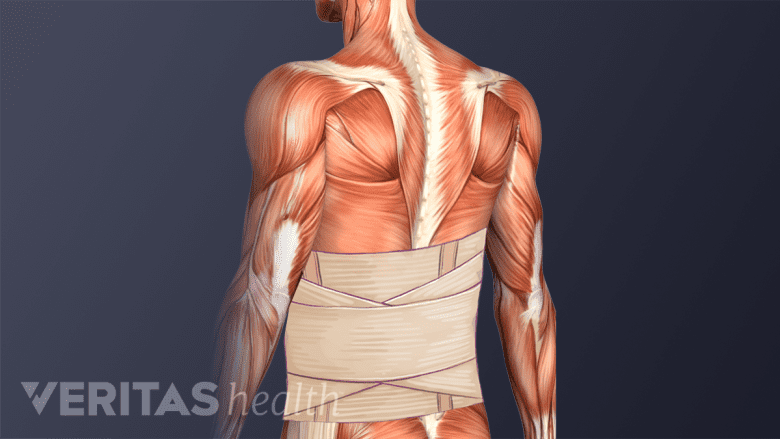When a patient returns home from scoliosis surgery, he or she will still be heavily medicated, weak, and in need of much rest. The patient will also have a list of precautions that must be strictly followed to protect and care for the healing spine.
During these first couple of weeks back at home, the patient will need the help of a friend, family member, or home health aide who can assist with some basic care and daily tasks. In addition, the patient will not be allowed to drive yet and should limit car rides.
In This Article:
- Scoliosis Surgery: Postoperative Care
- Scoliosis Surgery: Planning for Postoperative Care at Home
- Scoliosis Surgery Recovery: At the Hospital (4 to 7 Days)
- Scoliosis Surgery Recovery: After Discharge (First 14 Days)
- Scoliosis Surgery Recovery: After Discharge (2 Weeks to 3 Months)
- Scoliosis Surgery Recovery: 3 Months Post-Operation and Beyond
No Bending, Lifting, or Twisting

A lumbar brace can help stabilize the spine and assist in the recovery process.
The most basic of precautions for the patient during the recovery process will be “no BLTs.” These include:
- No bending. The patient is allowed to bend at the knees and hips, but not at the back.
- No lifting. Nothing should be lifted that is more than 8 pounds, which is about the weight of a gallon of milk. Someone else will need to handle tasks that require lifting more than that for now.
- No twisting. Even simple tasks often involve twisting the spine, but that motion will have to be restricted during recovery. For example, to avoid twisting (and bending) the spine while getting in and out of bed, the patient will need to use the “log roll” technique described on the previous page.
While it is important to follow these movement restrictions, it is normal for people to occasionally forget and move in a way that is not advised. This type of movement—bending, twisting, or lifting—will cause some additional pain during recovery and serve as a reminder not to move in that manner again.
Depending on the extent of the surgery, some surgeons may prescribe a back brace to be worn for part of the recovery period. If a brace has been prescribed, it will help the patient to avoid risky activities until the fusion and healing of the spine becomes more stable.
Pain Management Plan
A key component of recovering from scoliosis surgery is pain management, but it requires balance. On one hand, pain must be kept under control to enable the patient to concentrate on tasks and move around, which helps the recovery process. On the other hand, narcotic pain medication—which is strong and tends to control severe pain well—should not be taken for too long in order to reduce the risks of developing complications, such as addiction or other serious health problems.
It is advised that the patient go off narcotics as soon as he or she can effectively manage the pain with a weaker medication. Typically, a scoliosis surgery patient will transition off narcotic pain medication during the second week at home or shortly thereafter.
See Opioid Medication Potential Risks and Complications
Acetaminophen (e.g. Tylenol) is frequently recommended as a pain medication that scoliosis surgery patients might switch to after being on narcotics. However, NSAIDs, such as ibuprofen, naproxen, or COX-2 inhibitors (e.g. Advil, Aleve, Celebrex, and Motrin) are usually avoided for the first three months, because they might interfere with bone growth and could cause the fusion to fail.
Most patients are completely off pain medication four to six weeks after surgery.1Common questions about surgery for scoliosis. American Academy of Orthopaedic Surgeons website. https://orthoinfo.aaos.org/en/treatment/surgical-treatment-for-scoliosis. Updated August 2015. Although, some patients might take considerably longer before being ready to go off pain medication.
Incision Site Care
It is important to maintain good care of the incision site. Every day, the patient will need to keep that area clean and dry. Typically, no creams, ointments, or powders are recommended.
See Postoperative Care for Spinal Fusion Surgery
When the patient first starts taking showers again, which is usually upon returning home, the incision site must be covered—such as with an occlusive dressing provided by the hospital or taped saran wrap—to prevent it from getting too wet.
First Follow-Up Appointment
After 10 to 14 days at home, the patient will go in for the first follow-up appointment with the surgeon. At this appointment, the following is likely to occur:
- Surgeon assesses the patient’s recovery. The surgeon will inspect the patient to see if the wound has healed. The patient will be asked how the recovery at home has been going and whether they have encountered any problems.
- Patient asks questions. While recovering at home, the patient will have experienced many feelings and emotions, and encountered some unexpected challenges or questions about the future. This follow-up appointment is an opportunity for the patient to ask questions and perhaps get guidance for overcoming a new challenge.
- Plan for the future. Once the surgeon and patient have had a chance to discuss how the first two weeks at home have gone, the surgeon and/or medical team will outline a strategy for the patient to follow until the next appointment.
Usually at this first follow-up appointment, the patient will be given the OK to start taking baths if the incision has healed. The patient might also be transitioned off narcotics to an over-the-counter pain medication.
- 1 Common questions about surgery for scoliosis. American Academy of Orthopaedic Surgeons website. https://orthoinfo.aaos.org/en/treatment/surgical-treatment-for-scoliosis. Updated August 2015.

